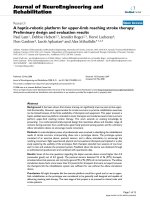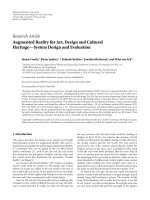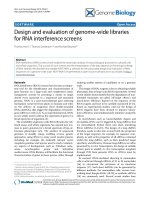MULTIPLE CHOICE QUESTIONS Design and Evaluation
Bạn đang xem bản rút gọn của tài liệu. Xem và tải ngay bản đầy đủ của tài liệu tại đây (88.26 KB, 37 trang )
1
MULTIPLE CHOICE QUESTIONS
DESIGN AND EVALUATION
Helen Huntley
Senior English Language Fellow
Ministry of Education and Training
Hanoi, Vietnam
2
Workshop Goals
To review the advantages and
disadvantages of multiple choice tests
To explore tips and techniques for
writing successful multiple choice items
To evaluate and correct multiple choice
questions and answers
3
Objective Testing
“Tests in which the learning material is
divided into small units, each of which
can be assessed by means of a test
item with a single correct answer that
can be specified in advance.”
Reed, J. (2000). Assessing vocabulary. Cambridge University
Press
4
Advantages of Multiple Choice
Tests
good discrimination among levels of ability
high reliability
valid indicators of overall language ability
highly practical: convenient to administer
well-established procedures to analyze items
writing ability does not affect performance
cost-effective format - easy scoring and
grading
familiarity of students with MCQs
5
Disadvantages of Multiple
Choice Tests
tendency to treat words as independent linguistic
units
difficulty in construction
field-testing, analysis, refinement required
25% chance of guessing correctly
items may test knowledge of distractors
wrong answer may result from lack of understanding
of syntax (English)
permits only limited sampling of total knowledge
tests only recognition knowledge
restricts what can be tested
washback may be harmful
cheating may be facilitated
6
Terminology
Every multiple choice item has a stem,
which presents a stimulus and several
options or alternatives to choose
from.
One of these options, the key, is the
correct response. The others serve as
distractors
7
Match the Test Items to the
Blueprint and Task Specifications
Addresses curriculum objectives in terms of
performance (can do)
Outline of the test
Skills to be included
Item types and tasks
Topics to be covered
Elicitation and response formats for items
Number of items in each section
Time allocation
Plan for scoring
8
Using Item Indices to Accept,
Discard, or Revise Items
Item facility: the extent to which an item is
easy or difficult for the proposed group of test
takers
Item discrimination: the extent to which
an item differentiates between high- and low-
ability test-takers
Distractor efficiency: the extent to which
the distractors ‘lure’ a sufficient number of
test takers
9
Multiple Choice Tips I
Each test item should be designed to measure a specific
objective
The question or task should be clear, testing only one
concept
The answer should involve interpretation of the material,
not just background knowledge
A context should be provided for the items
The items should not show an insensitive or unfair bias
The number of response options should be the same in
each question
Ambiguity in the answers must be avoided; the intended
answer should clearly be the only correct one.
The options should all be similar in length and level of
difficulty
10
Multiple Choice Tips II
Items at different levels of difficulty should be
included: start with the easiest first
Both the stem and options should be stated as
simply and directly as possible
Writing illogical or nonsensical distractors should be
avoided
Extraneous clues should not influence the answer
The correct answers should appear in all positions (A,
B, C, D)
Words should not be repeated in the answers
A negative ‘stem’ should be avoided The questions
should not be dependent on previous items
Appropriate punctuation should be used
11
Helpful Resources
ESL dictionaries
ESL online dictionaries
/>
Thesaurus
Online thesaurus
Grammar reference texts
High school textbooks
Flesh-Kincaid Readability Grade (MSW)
12
Sample MC Questions
Evaluate the following multiple choice
items.
What is the objective of each question?
Identify problem areas (see Multiple
Choice Tips)
Correct/improve problem areas
13
MCQ#1
Excuse me, do you know _____?
a. where is the post office
b. where the post office is
c. where post office is
14
MCQ#2
An architect is a person who does not
_____.
a. design automobiles
b. design buildings
c. design houses
d. design offices
15
MCQ#3
My sister _____ as an air hostess.
a. working
b. works
c. she works
d. job
16
MCQ#4
I usually participate in badminton
competitions _____ November.
a. from
b. on
c. at
d. to
17
MCQ#5
Tuesday and Wednesday come before
Thursday but after _____.
a. Sunday
b. Saturday
c. Monday
d. Friday
e. none of the above
18
MCQ#6
The answer to the last question is the
_____ day of the week.
a. first
b. forth
c. three
d. fifth
19
MCQ#7
Hilary lives in New York City. _____ works
in the hotel business.
a. her
b. he
c. him
d. she
20
MCQ#8
I’m thirsty. I think I’ll drink an _____.
a. orange
b. knife
c. apple cider
d. umbrella
21
MCQ#9
While Susan prepared the ____ for lunch,
her mother watched television.
a. kitchen
b. children
c. chicken
d. cartoon
22
MCQ#10
Can you type _____ on a computer?
a. typing
b. to type
c. typed
d. type
23
MCQ#11
Although the plan has some
disadvantages, they are outweighed
by the _____.
a. advantages
b. negatives
c. drawbacks
d. problem
24
MCQ#12
Roberto is lazy. He always takes a siesta
_____ the afternoon.
a. in
b. during
c. at
d. throughout
25
MCQ#13
My eyesight has really been deteriorating
lately. I wonder if I need glasses. I
think I’d better go to the _____ to
have my eyes checked.
a. pediatrician
b. dermatologist
c. optometrist
d. audiologist









